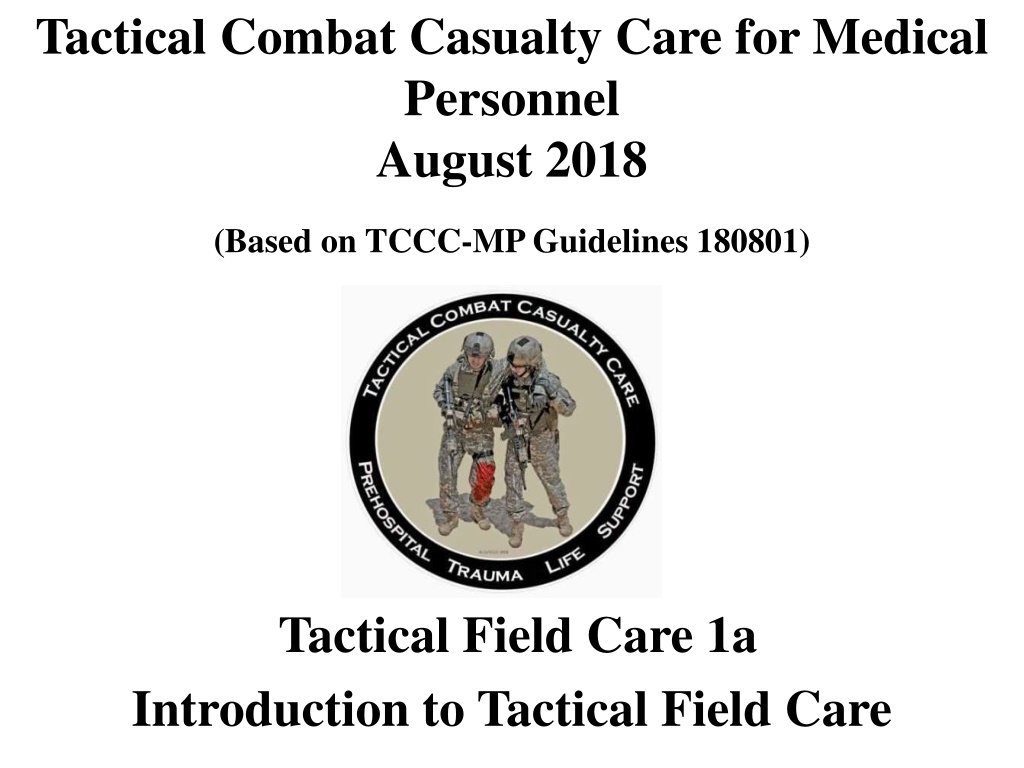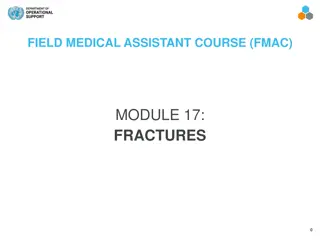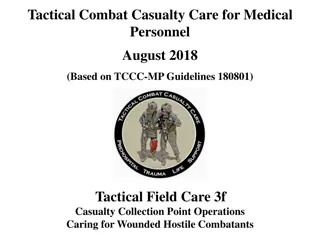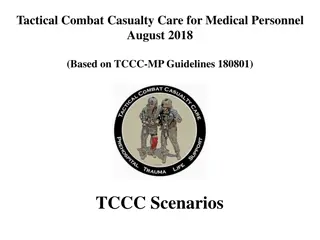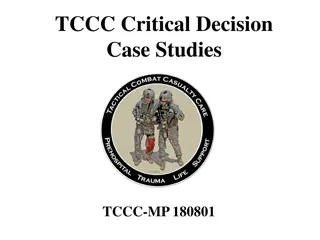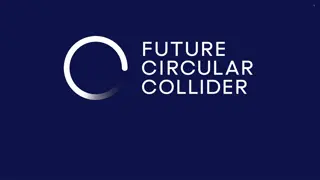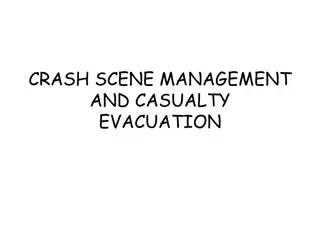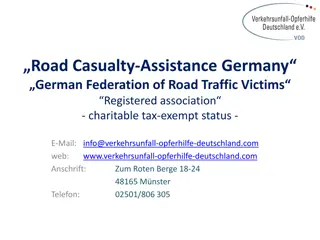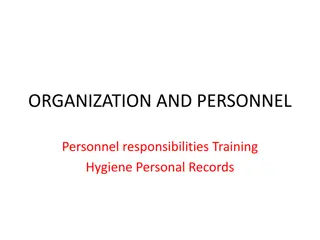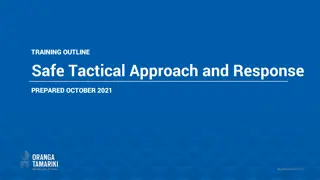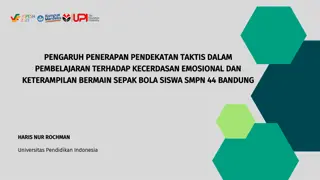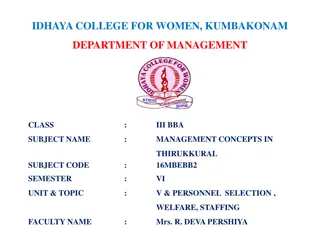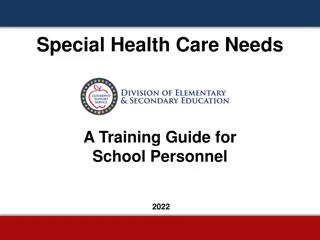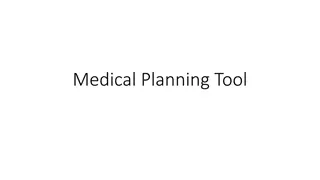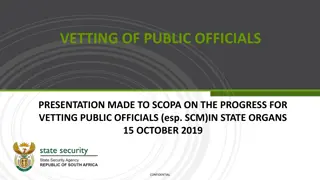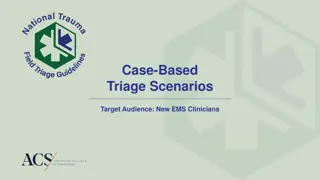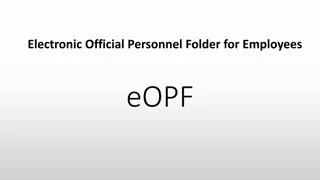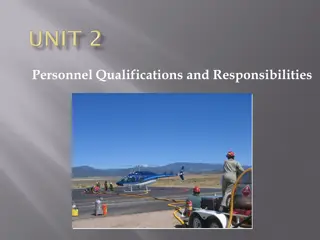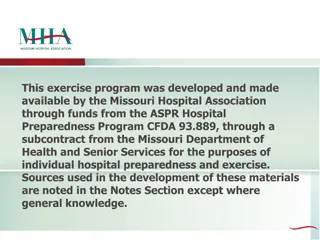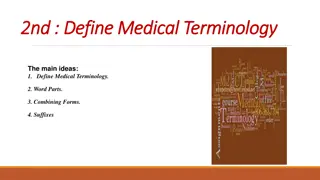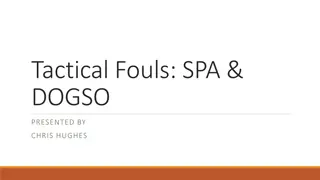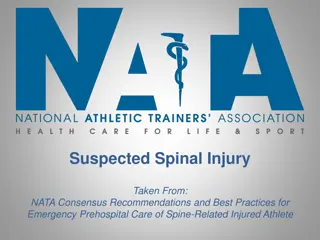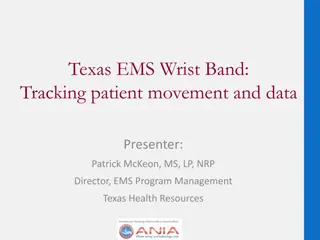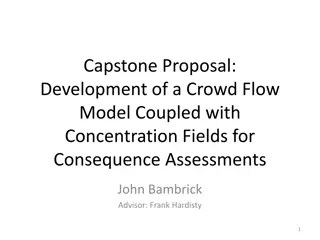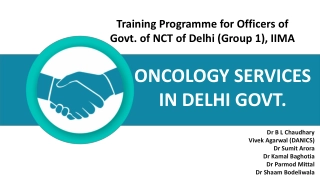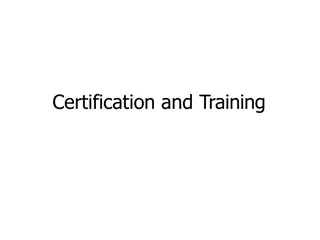Tactical Combat Casualty Care for Medical Personnel - Introduction to Tactical Field Care
Tactical Combat Casualty Care for Medical Personnel provides guidelines for Tactical Field Care, emphasizing the importance of perimeter security, recognizing altered mental status, and disarming casualties. It covers prioritization of treating life-threatening conditions, triage considerations, and tactical trauma assessment for preventable combat deaths. Distinguished from Care Under Fire, Tactical Field Care involves rapid treatment of serious wounds with varying evacuation times. The TFC phase aligns with the MARCH algorithm and USSOCOM Tactical Trauma Protocols.
Uploaded on Jul 28, 2024 | 0 Views
Download Presentation

Please find below an Image/Link to download the presentation.
The content on the website is provided AS IS for your information and personal use only. It may not be sold, licensed, or shared on other websites without obtaining consent from the author. Download presentation by click this link. If you encounter any issues during the download, it is possible that the publisher has removed the file from their server.
E N D
Presentation Transcript
Tactical Combat Casualty Care for Medical Personnel August 2018 (Based on TCCC-MP Guidelines 180801) Tactical Field Care 1a Introduction to Tactical Field Care
Disclaimer The opinions or assertions contained herein are the private views of the author and are not to be construed as official or as reflecting the views of the Departments of the Army, Air Force, Navy or the Department of Defense. - No disclosures
LEARNING OBJECTIVES Terminal Learning Objective Perform Tactical Field Care Enabling Learning Objectives Identify the importance of perimeter security in tactical field care. Identify the common causes of altered mental status on the battlefield. Identify the importance of disarming and securing communications gear of a casualty with altered mental status.
LEARNING OBJECTIVES Enabling Learning Objectives Describe the prioritization of treating life- threatening conditions using a tactical trauma assessment sequence such as the MARCH algorithm. Identify triage considerations in tactical field care. Determine appropriate treatment techniques for preventable causes of combat death. Demonstrate a Tactical Trauma Casualty Assessment.
Tactical Field Care Distinguished from Care Under Fire by: A reduced level of hazard from hostile fire More time available to provide care based on the tactical situation Medical gear is still limited to that carried by the medic or corpsman or unit members (may include gear in tactical vehicles)
Tactical Field Care May consist of rapid treatment of the most serious wounds with the expectation of a re- engagement with hostile forces at any moment, or There may be ample time to render whatever care is possible in the field. Time to evacuation may vary from minutes to several hours or longer.
Battlefield Priorities in the Tactical Field Care Phase The TFC presentations cover the care to be recommended in TFC. You must deal with your tactical situation and your casualties. The sequence of care in TFC is compatible with the MARCH algorithm found in the USSOCOM Tactical Trauma Protocols.
MARCH Massive hemorrhage control life- threatening bleeding. Airway establish and maintain a patent airway. Respiration decompress suspected tension pneumothorax, seal open chest wounds, and support ventilation/oxygenation as required.
MARCH Circulation establish IV/IO access and administer fluids as required to treat shock. Head injury/Hypothermia prevent/treat hypotension and hypoxia to prevent worsening of traumatic brain injury and prevent/treat hypothermia.
Tactical Field Care Guidelines 1. Establish a security perimeter in accordance with unit tactical standard operating procedures and/or battle drills. Maintain tactical situational awareness.
Tactical Field Care Guidelines 2. Triage casualties as required. Casualties with an altered mental status should have weapons and communications equipment taken away immediately.
Manage Casualties with Altered Mental Status A combatant with an altered mental status may use his weapons or radios inappropriately. Secure long gun, pistols, knives, grenades, explosives, and all communications gear. Possible causes of altered mental status are Traumatic Brain Injury (TBI), shock, hypoxia, and pain medications. Say to the casualty: Let Smith hold your weapon for you while I check you out.
